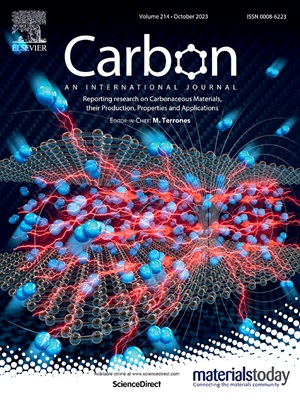Slippery and wear-resistant shape memory polymers enabled by the reinforcement of double transition metal-based MAX phase (Mo2TiAlC2)
IF 10.5
2区 材料科学
Q1 CHEMISTRY, PHYSICAL
引用次数: 0
Abstract
While polymeric components have emerged as potential replacements for metal counterparts in various moving mechanical systems, their unstable coefficient of friction and inferior wear resistance remain significant obstacles to their commercialization. MAX phase materials have demonstrated extraordinary potential for numerous applications, with Mn+1AXn-type MAX phases being studied mainly for tribological applications. Here, we, for the first time, utilize double transition metal carbide MxM'yAX(x+y-1)-based MAX phase materials, more specifically, Mo2TiAlC2 MAX phase, as the reinforcing agent within the shape memory polyurethane (PU) matrix. PU composites were fabricated via melt blending and injection molding, incorporating varying loadings of Mo2TiAlC2. Tribological performance was evaluated using a ball-on-disk tribometer under controlled conditions. The resulting composites demonstrated significant reductions in the coefficient of friction and substantial enhancements in wear resistance compared to pristine PU. Microstructural and spectroscopic analyses were employed to elucidate the underlying friction and wear control mechanisms. Thermomechanical testing further confirmed that the shape memory functionality of PU remained largely unaffected by the addition of filler. This discovery opens a new area of research for controlling the lubricating and wear properties of SMPs using a double transition metal carbide-based MAX phase, which can be extended to other polymeric and metallic systems.

通过增强双过渡金属基MAX相(Mo2TiAlC2)实现光滑耐磨的形状记忆聚合物
虽然聚合物组件已经成为各种移动机械系统中金属组件的潜在替代品,但其不稳定的摩擦系数和较差的耐磨性仍然是其商业化的重大障碍。MAX相材料在许多应用中显示出非凡的潜力,Mn+ 1axn型MAX相主要用于摩擦学应用。在这里,我们首次利用双过渡金属碳化物MxM'yAX(x+y-1)基MAX相材料,更具体地说,Mo2TiAlC2 MAX相,作为形状记忆聚氨酯(PU)基体中的增强剂。通过熔融共混和注射成型制备了不同Mo2TiAlC2含量的PU复合材料。在受控条件下,使用球盘式摩擦计评估摩擦性能。与原始PU相比,所得复合材料的摩擦系数显著降低,耐磨性显著提高。采用显微组织和光谱分析来阐明潜在的摩擦和磨损控制机制。热力学测试进一步证实,PU的形状记忆功能在很大程度上不受添加填料的影响。这一发现为利用双过渡金属碳化物为基础的MAX相控制SMPs的润滑和磨损性能开辟了一个新的研究领域,该领域可以扩展到其他聚合物和金属体系。
本文章由计算机程序翻译,如有差异,请以英文原文为准。
求助全文
约1分钟内获得全文
求助全文
来源期刊

Carbon
工程技术-材料科学:综合
CiteScore
20.80
自引率
7.30%
发文量
0
审稿时长
23 days
期刊介绍:
The journal Carbon is an international multidisciplinary forum for communicating scientific advances in the field of carbon materials. It reports new findings related to the formation, structure, properties, behaviors, and technological applications of carbons. Carbons are a broad class of ordered or disordered solid phases composed primarily of elemental carbon, including but not limited to carbon black, carbon fibers and filaments, carbon nanotubes, diamond and diamond-like carbon, fullerenes, glassy carbon, graphite, graphene, graphene-oxide, porous carbons, pyrolytic carbon, and other sp2 and non-sp2 hybridized carbon systems. Carbon is the companion title to the open access journal Carbon Trends. Relevant application areas for carbon materials include biology and medicine, catalysis, electronic, optoelectronic, spintronic, high-frequency, and photonic devices, energy storage and conversion systems, environmental applications and water treatment, smart materials and systems, and structural and thermal applications.
 求助内容:
求助内容: 应助结果提醒方式:
应助结果提醒方式:


